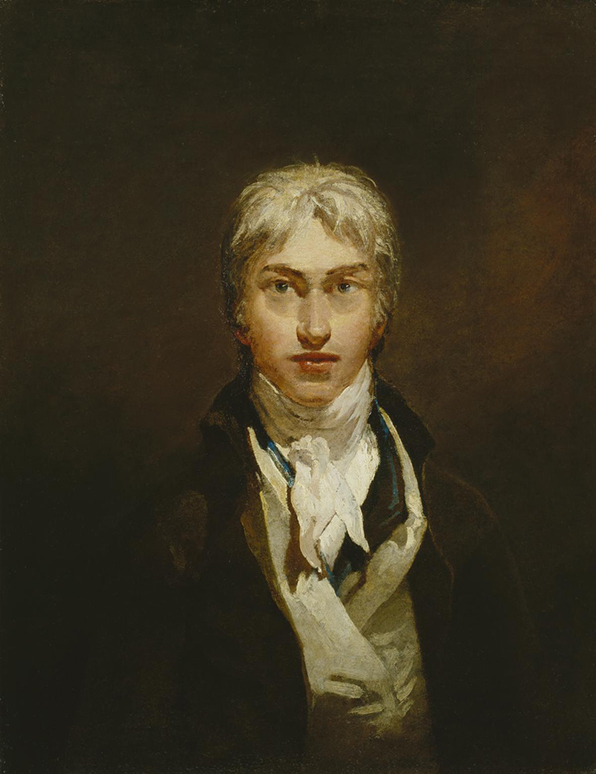
DECEMBER 15, 2018–MARCH 10, 2019
ABOUT THE ARTISTS
JOSEPH MALLORD WILLIAM TURNER, 1775–1851
Joseph Mallord William Turner (English, 1775–1851), Self-Portrait, c. 1799. Oil paint on canvas. Tate Britain. Accepted by the nation as part of the Turner Bequest 1856, N00458. Photo © Tate Britain. Image released under Creative Commons CC-BY-NC-ND (3.0 Unported)
Joseph Mallord William Turner was born in London in 1775, son of barber William Turner and Mary née Marshall. He entered the Royal Academy Schools in late 1789, earning full election to the Royal Academy in 1802. He exhibited regularly at that institution’s annual exhibitions and served as Professor of Perspective from 1808 to 1837, giving lectures to students and fellow academicians that were reportedly beautifully illustrated, but sometimes hard to understand given Turner’s thick cockney accent and tendency to mutter.
Turner traveled widely throughout Britain and Europe, capturing the wonders of the world including the rivers of France, the Alps of Switzerland, and the canals of Venice. He began his career as a topographical draughtsman, for which attention to detail and accuracy were paramount. His style evolved in order to capture the fleeting effects of light and atmosphere. Turner’s late oil paintings and watercolors verge on abstraction and are often erroneously thought to have inspired the French Impressionists: for all his travels, his paintings were little known outside of England. Critics of Turner’s day were largely uncomplimentary.
However, Turner was financially successful. From a young age, he was patronized by wealthy art collectors. He also supplied numerous designs engraved for publications that circulated widely. He attempted his own publication scheme, the Liber Studiorium, where he classified landscapes into different types and worked with mezzotint engravers to translate his landscapes into print for a wider audience. Turner built his own exhibition gallery in his London home, where he could show finished works to prospective buyers.
Turner never married. He may have fathered two children by a companion, but he never recognized these women as his daughters. In his will, Turner bequeathed his unsold finished works to the British government. The vast contents of his studio also made their way to national ownership. The Tate Britain, London now holds more than 37,000 works by the artist, including notebooks, sketches, and finished works that reveal his creative process.
JOHN CONSTABLE, 1776–1837
John Constable (English, 1776–1837), Self-Portrait, 1806. Graphite on paper. Tate Britain. Purchased 1984, T03899. Photo © Tate Britain. Image released under Creative Commons CC-BY-NC-ND (3.0 Unported)
John Constable was born in 1776, in East Bergholt, Suffolk, the son of wealthy mill owner Golding Constable and his wife Ann née Watts. Constable was educated at grammar school and began working for his father before he persuaded his parents to allow him to enter the Royal Academy Schools in 1799. While he began exhibiting at the Royal Academy’s annual summer exhibitions in 1802, he was not elected to full Academician until late in his career in 1829.
Constable endeavored to capture the essence of nature in his landscapes, inspired by the countryside around East Bergholt. Writing to his close friend John Fisher, he related: “Still I should paint my own places best; painting is with me but another word for feeling, and I associate ‘my careless boyhood’ with all that lies on the banks of the Stour; those scenes made me a painter, and I am grateful….”
Constable fell in love with Maria Bicknell, granddaughter of the rector at East Bergholt, and after a seven-year engagement, they married in 1816. Her health was poor—she suffered from tuberculosis—so the family often moved to places deemed healthful, including the coastal town of Brighton and the London suburb of Hampstead Heath. Constable painted the landscapes of these locales and other places of personal connection, including the area around Salisbury Cathedral, home to John Fisher and his uncle the Bishop of Salisbury, an early patron. Maria died in 1828, leaving Constable to care for their seven young children. He never remarried and wore black clothes in mourning for the rest of his life.
Constable sold relatively few landscapes during his lifetime. He painted portraits for income and lived on an inheritance from his father and, later, Maria’s inheritance. A number of Constable’s landscapes were exhibited in Paris to critical acclaim, and a dealer based there commissioned him to paint works for an interested market. Constable’s exacting study of nature and method of painting outdoors impressed French artists of his generation and inspired those who followed, including the Barbizon landscapists and the Impressionists.
At his death, Constable’s studio was full of finished works. In 1888, Constable’s daughter, Isabel, gave nearly 400 works—including oil paintings, watercolors, and graphite drawings—to the British nation. These are now in the collection of the Victoria and Albert Museum, London.


